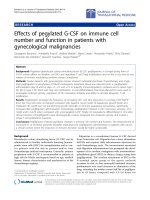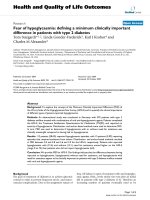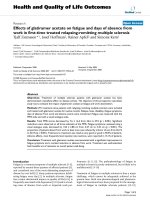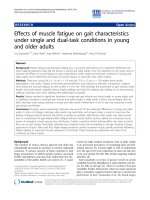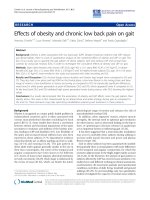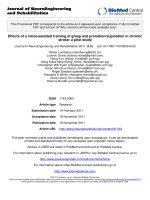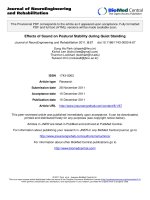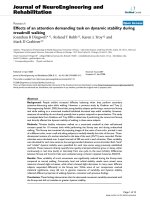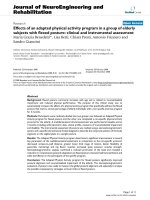báo cáo hóa học: " Effects of unilateral robotic limb loading on gait characteristics in subjects with chronic stroke" docx
Bạn đang xem bản rút gọn của tài liệu. Xem và tải ngay bản đầy đủ của tài liệu tại đây (907.99 KB, 8 trang )
JNER
JOURNAL OF NEUROENGINEERING
AND REHABILITATION
Khanna et al. Journal of NeuroEngineering and Rehabilitation 2010, 7:23
/>Open Access
RESEARCH
© 2010 Khanna et al; licensee BioMed Central Ltd. This is an Open Access article distributed under the terms of the Creative Commons
Attribution License ( which permits unrestricted use, distribution, and reproduction in
any medium, provided the original work is properly cited.
Research
Effects of unilateral robotic limb loading on gait
characteristics in subjects with chronic stroke
Ira Khanna
†1
, Anindo Roy*
†2,3,4
, Mary M Rodgers
†1
, Hermano I Krebs
†2,4,5
, Richard M Macko
1,3,4,6
and
Larry W Forrester
†1,3,4
Abstract
Background: Hemiparesis after stroke often leads to impaired ankle motor control that impacts gait function. In recent
studies, robotic devices have been developed to address this impairment. While capable of imparting forces to assist
during training and gait, these devices add mass to the paretic leg which might encumber patients' gait pattern. The
purpose of this study was to assess the effects of the added mass of one of these robots, the MIT's Anklebot, while
unpowered, on gait of chronic stroke survivors during overground and treadmill walking.
Methods: Nine chronic stroke survivors walked overground and on a treadmill with and without the anklebot
mounted on the paretic leg. Gait parameters, interlimb symmetry, and joint kinematics were collected for the four
conditions. Repeated-measures analysis of variance (ANOVA) tests were conducted to examine for possible differences
across four conditions for the paretic and nonparetic leg.
Results: The added inertia and friction of the unpowered anklebot had no statistically significant effect on spatio-
temporal parameters of gait, including paretic and nonparetic step time and stance percentage, in both overground
and treadmill conditions. Noteworthy, interlimb symmetry as characterized by relative stance duration was greater on
the treadmill than overground regardless of loading conditions. The presence of the unpowered robot loading
reduced the nonparetic knee peak flexion on the treadmill and paretic peak dorsiflexion overground (p < 0.05).
Conclusions: Our results suggest that for these subjects the added inertia and friction of this backdriveable robot did
not significantly alter their gait pattern.
Background
Over 795,000 strokes occur in the United States each year
[1]. Of those individuals that survive, approximately two-
thirds have residual motor deficits, including impaired
gait [1]. Lower extremity hemiparesis has been shown to
reduce walking speed and endurance [2-6] as well as gait
parameters such as step length [4,7] and stance duration
[8]. Studies have shown that impaired swing initiation,
abbreviated paretic single limb support [9,10], decreased
hip flexion, increased knee flexion, and increased ankle
plantarflexion at toe off [8] are all characteristic of hemi-
paretic gait.
Rehabilitation intervention has demonstrated signifi-
cant potential for improving motor function and gait
[3,11]. Traditional models of gait rehabilitation often
employ task-oriented exercises such as stepping and
weight shifting [12] as well as manual stretching to
increase range of motion and strength training [13].
Recent studies have shown that practice over a treadmill
can improve cardiovascular fitness and ambulatory per-
formance in individuals with hemiparetic gait [13-16]
including improved interlimb symmetry [15], cadence
and gait velocity [3,14,17,18]. A recent Cochrane Report
has reported that along with treadmill training, there is
evidence to suggest electromechanical gait training may
improve independent walking [19].
The Cochrane Report includes results observed in trials
with two devices, namely the Gait Trainer I and the Loko-
mat
®
. More recent studies have focused on robotic devices
for the ankle joint [20] to address the problem of drop
foot that occurs during hemiparetic gait [21]. For this
class of robotic devices, a possible confounding factor
* Correspondence:
2
Department of Mechanical Engineering, Massachusetts Institute of
T
echnology, Cambridge, Massachusetts, 02139, USA
†
Contributed equally
Full list of author information is available at the end of the article
Khanna et al. Journal of NeuroEngineering and Rehabilitation 2010, 7:23
/>Page 2 of 8
resulting from wearing the device during walking is the
added mass which might encumber patients' ability to
move, especially their leg during walking. Noble and
Prentice found that adding a 2 kg weight to the non-dom-
inant leg of young adults resulted in increased knee and
hip flexion during the swing phase as well as reduced
plantarflexion at toe off of the weighted limb [22]. Since
individuals with hemiparesis have asymmetric gait, the
addition of asymmetric loading to the paretic limb may
further increase asymmetry and affect gait kinematics.
For example, one study of individuals with post-stroke
hemiparesis showed that adding a unilateral weight to the
nonparetic leg increased hip and knee excursions in the
paretic limb [23].
Here we examined the effects of asymmetric or unilat-
eral loading of the paretic limb during task-oriented gait
therapy. Specifically, we sought to assess the effects of the
added inertia and friction of unpowered ankle robot on
gait parameters, interlimb symmetry, and lower extrem-
ity joint kinematics in chronic stroke survivors. We
examined these effects in two common rehabilitation
training scenarios: walking over ground (OG) and tread-
mill (TM) training. We hypothesized that loading the
paretic limb with the robot would change bilateral joint
kinematics.
Methods
Subjects
Ten chronic stage stroke survivors (4 males and 6
females) were recruited through the Veterans Affairs
(VA) Maryland Exercise and Robotics Center of Excel-
lence and the University of Maryland (UM) Claude D.
Pepper Older Americans Independence Center in Balti-
more, Maryland. Participants met the following inclusion
criteria: a) at least 6 months post ischemic stroke with
residual hemiparetic gait, b) able to walk on a treadmill,
and c) had a score greater than a 23 on the mini mental
state exam (MMSE) [24] and able to follow two step com-
mands. Individuals with unstable angina, congestive
heart failure within the last 3 months, major orthopedic
or chronic pain, poorly controlled hypertension, recent
hospitalization for severe disease or surgery, a history of
severe ankle injury or severe receptive aphasia were
excluded from the study. The study was approved by the
VA Rehabilitation Research and Development (RR&D)
Committee and UM Institutional Review Board, and
Massachusetts Institute of Technology's Committee on
the Use of Humans as Experimental Subjects (COUHES).
All participants signed informed consent and underwent
medical evaluations to establish eligibility.
Apparatus
The robot used in this study is a backdriveable or low
end-point impedance device that allows mobility at the
ankle joint in all three degrees of freedom (DOFs) but
actuates the ankle in only two of those three DOFs,
namely dorsi/plantarflexion and inversion/eversion (Fig-
ure 1). The anklebot weighs 3.6 Kg and has low static fric-
tion (<1 N-m). It is mounted proximally to the leg and
anterior to the shank to minimize perception of loading
[25]. It attaches to the subject's paretic limb by way of an
orthopedic knee brace (Townsend Design, Bakersfield,
CA) that is affixed to the thigh and shank by multiple
anterior and posterior Velcro straps, each positioned to
match the natural contour of the distal thigh and proxi-
mal shank segments. Pads protect the medial and lateral
condyles, where hinges approximate joint axes of rota-
tion. Orthopedic shoes with steel shank construction
secure the robot's distal attachment via quick-release
mechanisms as well as a single strap over the proximal
metatarsals. The robot connects to the knee brace proxi-
mally via a set of quick-release locking clamps. An adjust-
able shoulder strap that connects to the knee brace
provides additional anti-gravity support during the swing
phase of walking. Design and performance characteristics
of the anklebot have been described elsewhere [20].
Figure 1 Anklebot. The figure identifies the main components of the
device.
Shoulder strap
Knee brace
Foot
attachment
Actuators
Khanna et al. Journal of NeuroEngineering and Rehabilitation 2010, 7:23
/>Page 3 of 8
Procedure
Clinical assessments included a medical history, MMSE,
and active and passive ranges of motion (AROM and
PROM) [26] of the paretic hip, knee, and ankle joints. In
addition, spasticity for the paretic knee and ankle was
assessed using the Modified Ashworth Spasticity (MAS)
Scale [27]. Manual Muscle Testing (MMT) [28] was per-
formed for the hip, knee and ankle flexor and extensor
muscle groups. Body mass index (BMI) was also calcu-
lated for each participant.
Two separate sessions were scheduled to evaluate base-
line walking performance over ground and on the tread-
mill. The first session assessed participants' ability to
walk independently overground (OG) and on the tread-
mill (TM). The session began with three 10-meter walks
to determine participants' self-selected floor walking
velocity using an instrumented gait mat (GAITRite
®
, CIR
Systems, Havertown, Pa). We determined and attempted
to control the speed for all the following conditions from
this self-selected floor walking velocity. Participants,
then, walked OG and then on a TM (6 trials per condition
with TM trials lasting 15 seconds each). To minimize
fatigue, participants were asked to return for a second
session two days later when they repeated OG and then
TM walking while wearing the unpowered anklebot on
the paretic leg ("OGR" and "TMR" conditions, respec-
tively). When walking on the treadmill, individuals were
instructed to hold the handrails. Optimal fitting of the
anklebot was established for each participant prior to
walking to minimize its slippage during gait and to maxi-
mize subject comfort. Optotrak
®
motion analysis system
(Northern Digital Inc., Waterloo, Canada) was utilized
along with the MotionMonitor™ computer software to
collect gait kinematics. Light emitting diodes (LED) were
attached to the sacrum and the posterior mid-thigh, the
posterior mid-gastrocnemius, and lateral aspect of the
foot of each leg for 3-D motion analysis. Footswitches
(Myopac Jr., Run Technologies, Mission Viego, CA) were
placed inside the subjects' shoes to determine timing of
initial contact and the end of pre-swing in the gait cycle.
Before overground and treadmill trials, individuals were
asked to stand with feet shoulder width apart to collect
neutral stance measurement. The Lumbosacral (L5/S1)
joint, bilateral anterior superior iliac spine (ASIS), knee
joints, ankle joints, and feet positions were captured dur-
ing the neutral stance measurement. All kinematic vari-
ables were expressed with respect to this neutral stance
or "zero" angle. Participants were instructed to walk
across a 7.3 meter-long walkway at their self-selected
walking pace for all overground conditions. The calcu-
lated overground velocity was then utilized to set the
treadmill speed for both treadmill conditions. Partici-
pants practiced as needed to allow them to adapt to walk-
ing with the weight of the robot for both overground and
treadmill conditions. Each participant wore a gait belt
and was provided with standby assistance with one-min-
ute seated rests between trials to minimize fatigue. All
testing was conducted without subjects wearing any
ankle foot orthosis.
Data analysis
Kinematic and footswitch data were collected at 500 Hz
and filtered using a recursive low pass Butterworth filter
with cutoff frequency of 6 Hz. Files were exported for fur-
ther processing in Matlab software (MathWorks, Inc.,
MA) to analyze hip, knee and ankle kinematic data for
each gait cycle in which initial contacts were determined
via footswitches. An average of 3 gait cycles were col-
lected per trial for OG and OGR conditions, and 7 gait
cycles were collected per trial for TM and TMR condi-
tions. On average, 18 gait cycles were collected for over-
ground conditions and 42 gait cycles for treadmill
conditions for each subject. All kinematic data was nor-
malized to percent gait cycle. The average and standard
deviations of the normalized gait cycles per condition
were used in the statistical analysis. Additionally, foot-
switch data was utilized to determine percent stance and
step time for both paretic and nonparetic sides. A sym-
metry index (SI) was used to quantify paretic and nonpa-
retic percent stance symmetry in gait [29]:
where 0 ≤ SI ≤ 1 is the symmetry index and V
paretic
and
V
nonparetic
are paretic and nonparetic percent stance dura-
tions, respectively. A lower value of the symmetry index
indicates higher symmetry and vice versa with regards to
stance durations on paretic and nonparetic sides. In other
words, a symmetry index value of zero corresponds to
perfect symmetry.
Statistics
Repeated-measures analysis of variance (ANOVA) tests
were conducted to test our hypothesis comparing OG vs.
OGR and TM vs. TMR conditions using SAS
®
software
(SAS, Cary, NC). The variables that were compared were
paretic and nonparetic kinematics, step time and percent
stance. Repeated-measures ANOVA tests were also
employed to test the symmetry index. To compare across
conditions (overground and treadmill) in a secondary
analysis, we employed a post- hoc pair wise comparisons
using Tukey's test. The significance level was set at p =
0.05 for all tests.
SI
V
paretic
V
nonparetic
V
paretic
V
nonparetic
=
−
+
1
2
,
(1)
Khanna et al. Journal of NeuroEngineering and Rehabilitation 2010, 7:23
/>Page 4 of 8
Results
Demographic characteristics
Patient demographics are summarized in Table 1. Range
of motion (ROM) was measured from 0° using a clinical
goniometer. All ten participants were chronic-stage
stroke survivors who had suffered their first unilateral
stroke from 21 to 146 months prior to enrollment (mean
time post stroke of 66 months), were between 43 and 75
years of age (mean age of 63 years) had persistent lower
extremity hemiparesis (six left and four right paretic).The
paretic limb Modified Ashworth Spasticity scores ranged
from 0-1+ for knee flexors, 0-2 for knee extensors, 0-3 for
dorsiflexors and 0-2 for plantarflexors. The paretic limb
Manual Muscle test scores ranged from 1-5 for hip flex-
ion and extension, 2-5 for knee flexion, 1-5 for knee
extension, 0-5 for dorsiflexion and plantarflexion. One
subject (#10 in Table 1) was able to walk overground and
on the treadmill but, due to substantial weakness in her
hip flexors, she was unable to walk with the added robot
mass and was thus not included in the results.
Spatiotemporal gait parameters
Hemiparetic gait parameters for the four conditions are
presented in figure 2. The ANOVA tests for our hypothe-
sis resulted in no significant differences between OG and
OGR or between TM and TMR conditions except for
peak angles (see below). The post-hoc Tukey's test for our
secondary analysis which compared across overground
and treadmill conditions showed that the percent stance
on the paretic side was significantly higher in the TM
(63.7 ± 4.4) vs. OG (58.1 ± 6.3 p = 0.01) and that the per-
cent stance symmetry was significantly lower for the TM
(9.8 ± 9.3) condition compared to the OG (22.1 ± 10.7, p
= 0.003) condition indicating greater symmetry on the
treadmill. The percent stance on the nonparetic limb was
significantly higher in the OGR condition (73.5 ± 4.7)
compared to the TMR (71.2 ± 3.8 p = 0.03) conditions.
We also verified that as dictated by our protocol, the mea-
sured walking speed did not differ across conditions
(OG= 0.496 m/s ± 0.19 m/s, TM = 0.489 m/s ± 0.291 m/s,
OGR = 0.442 m/s ± 0.147 m/s, TMR = 0.478 m/s ± 0.292
m/s). There were no other significant differences between
conditions.
Peak angles
Figure 3 displays an example of the hip, knee and ankle
kinematics among the four conditions for a representa-
tive subject. The most notable difference is the significant
decrease in maximum paretic dorsiflexion during the
OGR condition (3.6° ± 5.5°, p = 0.009) compared to the
Table 1: Physical and demographic characteristics of stroke participants.
ID Age (yr)/
gender (M/F)
Paretic (L/R) Assistive
device
BMI [kg/m
2
] TPS [mos.] Range of Motion (°)
Paretic
Nonparetic
b
ADF APF ADF APF
1 60/M L None 26.3 21.6 -23 25 - -
2 75/M R SPC 23.3 146.4 3 34 17 43
3 60/F R AFO 22.7 88.8 -22 37 -4 45
4 53/F R AFO/SPC 20.9 37.2 -3 26 15 57
5 43/F L None 33.0 60.0 0 54 3 69
6 72/M L QC 26.3 52.8 -15 28 - -
7 60/F L None 30.0 88.8 -15 50 -10 62
8 68/M L None 26.7 18.0 -1 43 -1 54
9 64/F R None 27.5 56.4 0 35 15 53
10 73/F L SPC 23.9 84.0 -22 26 4 44
Mean 63(4M, 6F)
a a
6 L/4 R
a
2 AFOs, 4
canes
26.1 66.0 10.0 36.0 5.0 53.0
SD 10 3.6 38.4 10.6 10.3 9.9 9.2
a
Expressed as distribution.
List of abbreviations- M: male, F: female; L: left, R: right; AFO: ankle foot orthosis; SPC: single point cane; QC: quad cane; BMI: body mass index; TPS:
time post stroke; ADF, APF: active ankle dorsiflexion and plantarflexion, respectively with neutral (90°) subtracted.
b
Nonparetic range of motion for participants 1 and 6 are marked with dashes to indicate missing data because it was not measured in these two
individuals.
Khanna et al. Journal of NeuroEngineering and Rehabilitation 2010, 7:23
/>Page 5 of 8
OG (10.4° ± 3.7°, p = 0.009) condition. Also, nonparetic
maximum knee flexion was greater in the TM (64.1° ±
10.7°, p = 0.009) condition compared to the TMR (57.3° ±
12.5°, p = 0.009) condition. On the paretic side, maximum
hip flexion during the TM condition (35.0° ± 14.0°, p =
0.004) was higher compared to the OG condition (25.4° ±
10.9°, p = 0.004). Also, paretic maximum hip flexion dur-
ing the OGR condition (26.0° ± 10.2°, p = 0.016) was less
than for the TM (35.0° ± 14.0°, p = 0.016) and TMR (34.8°
± 13.3°, p = 0.016) conditions. Maximum nonparetic hip
flexion was greater in the TM (43.9° ± 11.6°, p = .046)
condition compared to the OGR (33.7° ± 9.1°, p = 0.046)
condition. There were no other significant differences
among conditions including the relative times at which
these peak values occurred in the gait cycle.
Discussion
These findings support our hypothesis that asymmetric
loading of the paretic limb would change bilateral joint
kinematics in individuals with hemiparetic gait secondary
to stroke. Specifically, the unpowered robot loading
reduced nonparetic peak knee flexion on the TM and
paretic peak dorsiflexion OG (p < 0.05). However surpris-
ingly, mounting the anklebot on the paretic leg leads to
no discernable differences in symmetry when walking
overground or on the treadmill. It is important to empha-
size that the entire study was conducted with the ankle-
Figure 2 Graphs for spatiotemporal and symmetry gait parameters. Average of 9 participants' spatiotemporal and symmetry gait parameters
(mean ± SD). These include the step time, stance time, velocity, and symmetry index for the paretic and nonparetic limbs for all four loading conditions
(OG no robot, OG with robot, TM no robot, and TM with robot).
1
OG: overground TM: treadmill OGR: overground with the robot TMR: treadmill with the robot
2
P: paretic NP: nonparetic
SI: symmetry index
3
indicates significant differences between conditions at P=0.05
*P < 0.05;
Khanna et al. Journal of NeuroEngineering and Rehabilitation 2010, 7:23
/>Page 6 of 8
Figure 3 Gait kinematics. Gait kinematics (mean ± SD) collected from a single representative subject for the hip, knee, and ankle joints during the
four conditions (OG no robot, OG with robot, TM no robot, and TM with robot). For each condition, a total of six (6) gait cycles were averaged. The
dashed lines indicate neutral stance taken before the trials.
0 20 40 60 80 100
-20
-10
0
10
20
30
40
50
60
Paretic Hip
Paretic Hip Angle (degrees)
Extension Flexion
% Gait Cycle
OG no Robot
OG with Robot
TM no Robot
TM with Robot
0 20 40 60 80 100
-20
-10
0
10
20
30
40
50
60
Nonparetic Hip
Nonparetic Hip Angle (degrees)
Extension Flexion
% Gait Cycle
OG no Robot
OG with Robot
TM no Robot
TM with Robot
0 20 40 60 80 100
-80
-70
-60
-50
-40
-30
-20
-10
0
10
Nonparetic Knee
Nonparetic Knee Angle (degrees)
Flexion Extension
% Gait Cycle
OG no Robot
OG with Robot
TM no Robot
TM with Robot
0 20 40 60 80 100
-80
-70
-60
-50
-40
-30
-20
-10
0
10
Paretic Knee
Paretic Knee Angle (degrees)
Flexion Extension
% Gait Cycle
OG no Robot
OG with Robot
TM no Robot
TM with Robot
0 20 40 60 80 100
-15
-10
-5
0
5
10
15
20
Paretic Ankle
Paretic Ankle Angle (degrees)
Plantarflexion Dorsiflexion
% Gait Cycle
OG no Robot
OG with Robot
TM no Robot
TM with Robot
0 20 40 60 80 100
-15
-10
-5
0
5
10
15
20
Nonparetic Ankle
Nonparetic Ankle Angle (degrees)
Plantarflexion Dorsiflexion
% Gait Cycle
OG no Robot
OG with Robot
TM no Robot
TM with Robot
Khanna et al. Journal of NeuroEngineering and Rehabilitation 2010, 7:23
/>Page 7 of 8
bot unpowered. When actively generating training
torques at the ankle, these differences due to its added
inertia and friction might get even smaller. As for our sec-
ondary analysis, similar to others [15], we found that
walking on the treadmill showed greater symmetry than
walking overground.
Previous work indicated that on average individuals
with stroke walked overground at a faster preferred speed
than on the treadmill [16]. These results were unlike our
findings since we sought to control for differences in
speed to allow comparison across conditions. Therefore,
the speed in TM and TMR conditions was set to match
the OG velocity. The OGR velocity was not directly con-
trolled; however, subjects still walked at a velocity similar
to the other conditions.
For the individuals with stroke there were no major dis-
similarities in bilateral step times and paretic stance
among conditions. The variations in nonparetic stance
durations were attributed to the overground and tread-
mill conditions as opposed to the added loading. The
symmetry calculations showed that in the TM condition
there was more symmetry between paretic and nonpa-
retic stance phases compared to the OG condition. These
findings were similar to previous studies that have shown
greater symmetry when walking on a treadmill compared
to over ground [3,15,17].
Our kinematic data also showed a 9°-10° increase in
paretic maximum hip flexion on the treadmill regardless
of loading condition. This difference may be attributable
to an increased postural stability obtained due to holding
the handrails on the treadmill. Also, there was a signifi-
cant decrease in paretic maximum hip flexion in the
OGR condition compared to both TM and TMR condi-
tions. The ability to produce greater paretic hip flexion in
the TMR versus OGR conditions indicates that the tread-
mill facilitated a greater hip range of motion. This under-
scores the fact that the added loading was not as
influential as the treadmill in affecting these parameters.
In contrast, nonparetic maximum knee flexion during the
swing phase differed between the two treadmill condi-
tions suggesting that this could have been due to the
added robot loading. Furthermore, the robot loading sig-
nificantly limited paretic ankle dorsiflexion during over-
ground but not in the treadmill training. Our findings are
distinct from prior studies where unilateral loading of
healthy individuals showed major effect on ankle kine-
matics while they were walking on a treadmill [30-32].
These differences could be because on the treadmill,
stroke volunteers benefited from greater postural support
which may have caused the longer paretic side stance
durations and altering loading responses observed at the
paretic ankle. This could have been due to the repetitive
nature of the treadmill task which may have potentially
suppressed some of the features characteristic of
impaired gait (e.g. circumduction).
Contrary to our findings, previous work has shown that
unilateral loading of a limb during treadmill gait does not
result in significant differences in hip or knee kinematics
[31]. This could be due to a lighter mass (approx. 1.7 kg)
used to unilaterally load the limb in [31] which was less
than half the mass of our ankle robot (approx. 3.6 kg). In
addition, subject demographics could have also contrib-
uted to these differences, i.e., participants in [31]
included three healthy males whereas all our participants
were chronic stroke survivors. Overall, our results appear
to suggest that walking on the treadmill with the leg uni-
laterally loaded or not has little impact on ankle kinemat-
ics. Furthermore, these kinematic deviations may be
further reduced when the anklebot is used in active
mode.
Of interest, not all subjects were able to ambulate with
the added mass. Nine of the ten participants were able to
ambulate with the added loading and those nine stroke
survivors self-reported that they could wear the anklebot
comfortably while walking overground and on the tread-
mill. One of the caveats of the study is that the small sam-
ple size is small; therefore, it was difficult to generate an
accurate deficit profile for usage (i.e. to determine which
individuals with hemiparesis can and cannot tolerate the
weight of the ankle robot.)
Conclusions
In conclusion, the present data suggests that many indi-
viduals with hemiparesis can potentially wear an exoskel-
eton robot safely and with minimum disruption of their
unloaded gait pattern.
List of abbreviations
ANOVA: analysis of variance; AROM: active range of
motion; BMI: body mass index; MMSE: mini mental state
exam; MMT: Manual Muscle Testing; OG: overground;
OGR: overground with the robot; PROM: passive range
of motion; SI: symmetry index; TM: treadmill; TMR:
treadmill with the robot; UM: University of Maryland;
VA: Veterans Affairs.
Competing interests
Dr. H. I. Krebs holds equity position in Interactive Motion Technologies, Inc., the
company that manufactures this type of technology under license to MIT and
VA.
Authors' contributions
IK was involved with data collection and analysis, and drafting of the manu-
script. AR, MMR, HIK, RMM, and LWF were involved in contributions to concep-
tion and design of the study, interpretation of data, and supervising the
manuscript critically for important intellectual content, and AR additionally
helped in data collection and analysis. All authors read and approved the final
manuscript.
Khanna et al. Journal of NeuroEngineering and Rehabilitation 2010, 7:23
/>Page 8 of 8
Acknowledgements
This work was supported by the Baltimore Veterans Affairs Medical Center
"Center of Excellence on Task-Oriented Exercise and Robotics in Neurological
Diseases" under Grant B3688R. VA Advanced Career Development Award
under grant B3390K, VA Medical Center Baltimore Geriatrics Research, Educa-
tion and Clinical Center (GRECC), University of Maryland School of Medicine,
(NIA: Claude D. Pepper Older Americans Independence Act Center) Pepper
Center grant P60AG12583.
Author Details
1
Department Physical Therapy and Rehabilitation Science, University of
Maryland School of Medicine, Baltimore, Maryland, 21201, USA,
2
Department
of Mechanical Engineering, Massachusetts Institute of Technology, Cambridge,
Massachusetts, 02139, USA,
3
Research Rehabilitation and Development,
Baltimore Veterans Affairs Medical Center, Baltimore, Maryland, 21201, USA,
4
Department of Neurology, University of Maryland School of Medicine,
Baltimore, Maryland, 21201, USA,
5
Department of Neurology and
Neuroscience, Weill Medical College of Cornell University, New York, New York,
10021, USA and
6
Department of Medicine, University of Maryland School of
Medicine, Baltimore, Maryland 21201, USA
References
1. Heart Disease and Stroke Statistics- 2009 update, American Heart
Association [ />2. Knutsson E, Richards C: Different types of disturbed motor control in
gait of hemiplegic patients. Brain 1979, 102:405-430.
3. Chen G, Patten C, Kothari DH, Zajac FE: Gait deviations associated with
post-stroke hemiparesis: improvement during treadmill walking using
weight support, speed, support stiffness, and handrail hold. Gait
Posture 2005, 22:57-62.
4. Hsu AL, Tang PF, Jan MH: Analysis of impairments influencing gait
velocity and asymmetry of hemiplegic patients after mild to moderate
stroke. Arch Phys Med Rehabil 2003, 84:1185-1193.
5. Brandstater ME, de Bruin H, Gowland C, Clark BM: Hemiplegic gait:
analysis of temporal variables. Arch Phys Med Rehabil 1983, 64:583-587.
6. Olney SJ, Griffin MP, McBride ID: Temporal, kinematic, and kinetic
variables related to gait speed in subjects with hemiplegia: a
regression approach. Phys Ther 1994, 74:872-885.
7. Olney SJ, Monga TN, Costigan PA: Mechanical energy of walking of
stroke patients. Arch Phys Med Rehabil 1986, 67:92-98.
8. Olney SJ, Richards C: Hemiparetic gait following stroke. Part I:
Characteristics. Gait Posture 1996, 4:136-148 [ />rudolph/gaitJC/Olney-1996.pdf].
9. Chen G, Patten C, Kothari DH, Zajac FE: Gait differences between
individuals with post-stroke hemiparesis and non-disabled controls at
matched speeds. Gait Posture 2005, 22:51-56.
10. Bensoussan L, Mesure S, Viton JM, Delarque A: Kinematic and Kinetic
Asymmetries in Hemiplegic Patients' Gait Initiation Patterns. J Rehabil
Med 2006, 38:287-294.
11. Olney S, Richards C: Hemiparetic gait following stroke. Part II: Recovery
and physical therapy. Gait Posture 1996, 4(2):149-162.
12. Marigold DS, Eng JJ, Dawson AS, Inglis JT, Harris JE, Gylfadottir S: Exercise
Leads to Faster Postural Reflexes, Improved Balance and Mobility, and
Fewer Falls in Older Persons with Chronic Stroke. J Am Geriatr Soc 2005,
53:416-423.
13. Hesse S, Bertelt C, Jahnke MT, Schaffrin A, Baake P, Malezic M, Mauritz KH:
Treadmill training with partial body weight support compared with
physiotherapy in nonambulatory hemiparetic patients. Stroke 1995,
26:976-81.
14. Silver KH, Macko RF, Forrester LW, Goldberg AP, Smith GV: Effects of
aerobic treadmill training on gait velocity, cadence, and gait symmetry
in chronic hemiparetic stroke: a preliminary report. Neurorehabil Neural
Repair 2000, 14:65-71.
15. Harris-Love ML, Forrester LW, Macko RF, Silver KH, Smith GVS: Hemiparetic
Gait Parameters in Overground Versus Treadmill Walking. Neurorehabil
Neural Repair 2001, 15(2):105-112.
16. Macko RF, Ivey FM, Forrester LW, Hanley D, Sorkin JD, Katzel LI, Silver KH,
Goldberg AP: Treadmill Exercise Rehabilitation Improves Ambulatory
Function and Cardiovascular Fitness in Patients With Chronic Stroke A
Randomized, Controlled Trial. Stroke 2005, 36:2206-2211.
17. Hesse S, Konrad M, Uhlenbrock D: Treadmill walking with partial body
weight support versus floor walking in hemiparetic subjects. Arch Phys
Med Rehabil 1999, 80:421-427.
18. Sullivan KJ, Knowlton BJ, Dobkin BH: Step Training With Body Weight
Support: Effect of Treadmill Speed and Practice Paradigms on
Poststroke Locomotor Recovery.
Arch Phys Med Rehabil 2002,
83:683-691.
19. Mehrholz J, Werner C, Kugler J, Pohl M: Electromechanical-assisted
training for walking after stroke. Cochrane Database Syst Rev 2007,
4:CD006185.
20. Roy A, Krebs HI, Williams DJ, Bever CT, Forrester LW, Macko RM, Hogan N:
Robot-Aided Neurorehabilitation: A Novel Robot For Ankle
Rehabilitation. IEEE Transactions on Robotics 2009, 25(3569-582 [http://
ieeexplore.ieee.org/xpl/freeabs_all.jsp?arnumber=4909072].
21. Blaya JA, Herr H: Adaptive Control of a Variable-Impedance Ankle-Foot
Orthosis to Assist Drop-Foot Gait. IEEE Trans Neural Syst Rehabil Eng 2004,
12:24-31.
22. Noble JW, Prentice SD: Adaptation to unilateral change in lower limb
mechanical properties during human walking. Exp Brain Res 2006,
169(4):482-495.
23. Regnaux JP, Pradon D, Roche N, Robertson J, Bussel B, Dobkin B: Effects of
loading the unaffected limb for one session of locomotor training on
laboratory measures of gait in stroke. Clin Biomech (Bristol, Avon). 2008,
23(6):762-768.
24. Folstein MF, Folstein SE, McHugh PR: 'Mini-mental state'. A practical
method for grading the cognitive state of patients for the clinician. J
Psychiatr Res 1975, 12:189-198.
25. Jones LA: Perceptual constancy and the perceived magnitude of
muscle forces. Exp Brain Res 2003, 151(12):197-203.
26. Kendall FP, McCreary EK, Provance PG, Rodgers MM, Romani WA: Muscles,
Testing and Function With Posture and Pain 5th edition. Baltimore: Williams
& Wilkins; 2005.
27. Bohannon RW, Smith MB: Interrater reliability of a modified Ashworth
scale of muscle spasticity. Phys Ther 1987, 67:206-207.
28. Kendall FP, McCreary EK, Provance PG: Muscles: Testing and Function.
4th edition. Baltimore: Williams & Wilkins; 1993:270.
29. Kim MC, Eng JJ: Symmetry in vertical ground reaction force is
accompanied by symmetry in temporal but not distance variables of
gait in persons with stroke. Gait Posture 2003, 18:23-8.
30. Ferris DP, Czerniecki JM, Hannafold B: An Ankle-Foot Orthosis Powered
by Artificial Pneumatic Muscles. Journal of Applied Biomechanics 2005,
21:189-197.
31. Gordon KE, Sawicki GS, Ferris DP: Mechanical performance of artificial
pneumatic muscles to power an ankle-foot orthosis. Journal of
Biomechanics 2006, 39:1832-1841.
32. Wheeler JW, Krebs HI, Hogan N: An Ankle Robot for a Modular Gait
Rehabilitation System. IEEE 2004, 2:1680-1684.
doi: 10.1186/1743-0003-7-23
Cite this article as: Khanna et al., Effects of unilateral robotic limb loading on
gait characteristics in subjects with chronic stroke Journal of NeuroEngineer-
ing and Rehabilitation 2010, 7:23
Received: 6 November 2009 Accepted: 21 May 2010
Published: 21 May 2010
This article is available from: 2010 Khanna et al; licensee BioMed Central Ltd. This is an Open Access article distributed under the terms of the Creative Commons Attribution License ( ), which permits unrestricted use, distribution, and reproduction in any medium, provided the original work is properly cited.Journal of NeuroEn gineerin g and Reha bilitatio n 2010, 7:23
